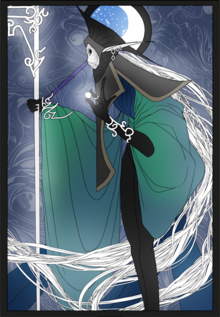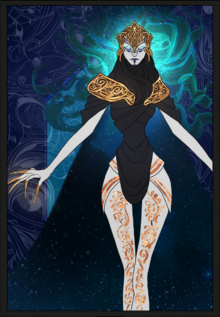More actions
No edit summary |
No edit summary |
||
| Line 69: | Line 69: | ||
* '''Allies:''' The only ally Cemaan needs is herself, all will know her rule in time. | * '''Allies:''' The only ally Cemaan needs is herself, all will know her rule in time. | ||
* '''Enemies:''' Hrymrök followers, Baskarr followers, Savellon followers, Theomar followers. | * '''Enemies:''' Hrymrök followers, Baskarr followers, Savellon followers, Theomar followers. | ||
* '''Favor:''' Cemaan is the creator | * '''Favor:''' Cemaan is the creator and patron saint of the Allorn Empire and Elf Nationalism. | ||
* '''Rituals:''' The Acceptance of Fealty where all who owe a Cemaan Worshiper favors ritualistically pledge their allegiance and servitude, the Great Moot of Conquest where a Cemaan Worshiper attempts to convince the rest of the Estelley community that an enemy group must be eradicated and driven underground, burnings of Ashal texts and relics. | * '''Rituals:''' The Acceptance of Fealty where all who owe a Cemaan Worshiper favors ritualistically pledge their allegiance and servitude, the Great Moot of Conquest where a Cemaan Worshiper attempts to convince the rest of the Estelley community that an enemy group must be eradicated and driven underground, burnings of Ashal texts and relics. | ||
|} | |} | ||
| Line 86: | Line 86: | ||
* '''Temple:''' Melca's largest Temple is the House of Warning in Xaster Xan-Xavacellon. | * '''Temple:''' Melca's largest Temple is the House of Warning in Xaster Xan-Xavacellon. | ||
* '''Allies:''' Elen followers, Elkonur followers, Severena followers, Tarnan followers. | * '''Allies:''' Elen followers, Elkonur followers, Severena followers, Tarnan followers. | ||
* '''Enemies:''' Gahan followers, Rand followers, Kathar, Theurgists | * '''Enemies:''' Gahan followers, Rand followers, Kathar, Theurgists and Summoners. | ||
* '''Favor:''' Melca is seen as a patron of the Sihndar | * '''Favor:''' Melca is seen as a patron of the Sihndar and their holy Blue Sky Wardens. | ||
* '''Rituals:''' Melca's worshipers invoke "pity them, Melca" before battle with any mortal, as they would rather turn their swords on Spirits only. Their Blue Sky Wardens, clad in ceremonial Melcarite armor (see her art), travel the world in search of new weapons for future calamities. The purest form of Melca Worship is banishing Void Spirits. | * '''Rituals:''' Melca's worshipers invoke "pity them, Melca" before battle with any mortal, as they would rather turn their swords on Spirits only. Their Blue Sky Wardens, clad in ceremonial Melcarite armor (see her art), travel the world in search of new weapons for future calamities. The purest form of Melca Worship is banishing Void Spirits. | ||
|} | |} | ||
| Line 119: | Line 119: | ||
* '''Traits:''' Motherly, Wistful, Amicable, Insightful, Passionate, Giving. | * '''Traits:''' Motherly, Wistful, Amicable, Insightful, Passionate, Giving. | ||
* '''Temple:''' Avinla's largest Temple is Dhruvagni Niketa in Avela Travinda. | * '''Temple:''' Avinla's largest Temple is Dhruvagni Niketa in Avela Travinda. | ||
* '''Allies:''' Efrat followers, | * '''Allies:''' Efrat followers, Leif followers, carpenters and craftsmen. | ||
* '''Enemies:''' Ordial Entities, Kathar, Evolist followers, murderers. | * '''Enemies:''' Ordial Entities, Kathar, Evolist followers, murderers. | ||
* '''Favor:''' Avinla is seen as a patron of the Suvial people. | * '''Favor:''' Avinla is seen as a patron of the Suvial people. | ||
| Line 138: | Line 138: | ||
* '''Enemies:''' Ordial Entities and Spirit enslavers who would rob his Faithful of death. | * '''Enemies:''' Ordial Entities and Spirit enslavers who would rob his Faithful of death. | ||
* '''Favor:''' Ammuloa is seen as a patron of the Fin'ullen people and Deathwatch Undead. | * '''Favor:''' Ammuloa is seen as a patron of the Fin'ullen people and Deathwatch Undead. | ||
* '''Rituals:''' Ammuloa's most famous ritual is his | * '''Rituals:''' Ammuloa's most famous ritual is his Rite, by which a living faithful is sacrificed and turned Undead with the sacred task to guard a name, a place, or a family until their destiny is fulfilled and they can rest. Ammuloa worshipers also practice reading scrolls of achievements of the famous slain, so that others know to live up to their example. | ||
|} | |} | ||
</center> | </center> | ||
| Line 153: | Line 153: | ||
* '''Traits:''' Resolute, Stalwart, Defiant, Stubborn, All-Knowing, Contemplative. | * '''Traits:''' Resolute, Stalwart, Defiant, Stubborn, All-Knowing, Contemplative. | ||
* '''Temple:''' Dáuw's largest Temple is the Great Chamber in Rammuur, Ellador. | * '''Temple:''' Dáuw's largest Temple is the Great Chamber in Rammuur, Ellador. | ||
* '''Allies:''' | * '''Allies:''' Guided Unionism followers, Theomar followers, Aelrrigan Knights. | ||
* '''Enemies:''' Anarchists, Evolism followers, | * '''Enemies:''' Argentum Knights, Anarchists, Evolism followers, Regalia-Haters. | ||
* ''' | * '''Favor:''' Sinnavei is seen as a patron of the Solvaan and the Regalian Empire. | ||
* '''Rituals:''' Dáuw have changed over the years, changing from justice and order-reinforcing rituals, to rituals more centered around Dwarven culture, as a byproduct of the catastrophic population decline of the Dwarves. Any festival or event that celebrates, highlights, or discusses and educates on Dwarven Culture is a form of worship to Dáuw. | * '''Rituals:''' Dáuw have changed over the years, changing from justice and order-reinforcing rituals, to rituals more centered around Dwarven culture, as a byproduct of the catastrophic population decline of the Dwarves. Any festival or event that celebrates, highlights, or discusses and educates on Dwarven Culture is a form of worship to Dáuw. | ||
* '''Rituals:''' Sinnavei's liveliest ritual is the Great Hall Muster where soldiers give one another gifts of equipment and good blessings for the battles to come, | |||
|} | |} | ||
</td><td style="vertical-align: top; width: 50%;"> | </td><td style="vertical-align: top; width: 50%;"> | ||
Revision as of 22:43, 23 September 2023
| Estelley | |
|---|---|
 | |
| Religion | |
| Pronunciation | Estel-lei |
| Origins | 15,000 years ago. |
| Deities | |
| 10 unified Gods. | |
Estelley is the ancient faith of air and light, a proud, judgmental religion that demands the best of its worshipers so that the world might be redeemed and men suffer no longer. It is primarily the domain of the Elven Races and cultures, though others convert if they believe that the Estelley Gods may give them grace and protect their people, or that its clear and defined virtues are easier to live by than those of their native religion. Estelley worshipers believe that they are opposed in their divine struggle both by those who teach alternative paths to paradise and those who seek to corrupt the world alike, but that Estel's truth and the truth of her prophets will emerge victorious, and that mortal heroes will see the Elves to a golden age where they want for nothing and no one.
Origins
Estelley is rooted in the history of the Elven Races, even though its followers do not all belong to that people. It is understood that early Elven history played host to a patchwork of bronze-working kingdoms in a strange world far unlike the modern one, murals depicting lanky and alien-looking long-eared mortals doing business with the Dewamenet, the similarly oversized, though muscular ancestors of the Asha, and a whole range of other cultures that have since been erased from Aloria. Each kingdom tended to favor a single patron god, the divinities bickering and fighting like the people did, until Estelley's first prophetess Talea swept through like a wildfire conquering throne after throne and uniting the Gods she went under the dogma of the over-deity Estel, a sleeping creation goddess who rests in the world beyond. Talea's divine right was proved at the tip of her spear and down the barrel of her spellcraft: uniting the Elves into the first iteration of Estelley dogma, recorded on a variety of stone slates and obelisks meticulously handed down. While Estelley is associated with Exist Magic and the powers of that Dimension due to Estel's lordship over it, they have a more complex understanding of their own Gods. While the Void and Ordial Gods had to sign bargains with other entities to escape their own Dimensions into Aloria's reality, the Estelley Gods were always native to the mortal plane and came into their arcane powers later, as a gift from Estel through Talea in a single mystery-shrouded event called "the Convergence". The Convergence is tied to the similarly murky Elven-Dewamenet War, which ended in that people's subjugation and enslavement: and so it is unlikely that a clear answer will ever be passed down about what the Convergence was or what it entailed, even from the lips of the Gods themselves.
Since Talea there have been two more prophets, no less important than she. Second was her younger brother Sanraan, who after the destruction of the Dewamenet cursed the Allorn victory as a defeat and proclaimed that an Empire built on poison would not last, and third was her youngest brother Fenhellëy who wrote the codes of governance and proper rule, also beginning the tradition of favoring Leyon as Estelley's highest god that would eventually become dominant outside the Allorn Empire. There have been no major modifications to Estelley dogma since the time of Fenhellëy, a boon and a curse at once. For while Estelley worshipers can claim with confidence that they have the most unedited and accurate religion to the exact practice of their forefathers, their faith's inability to change has often led to its defeat in its struggle against the usurping religions that have challenged it throughout history. Despite this, Estelley is still one of the world's most popular religions practiced by a large range of cultures, and has a presence in most major states.
Core Beliefs
Estelley preaches that the world was created inherently flawed, and that it is the Estelley Gods who shall lead the people closer to perfection so that Estel might, when the last sinner disappears from Aloria, remake it in her divine image and merge the realms of the living and the dead. It does not deny the strength of divinities from other religions, such as Unionist Divines or even its hated enemies the Void Gods, but believes that they were created to lead mortals astray. Each Estelley God has a different role to play in bringing about this perfect world, and while priests and written dogma are allowed to be incorrect, the Gods are considered infallible by way of their divinity. This has led to complicated situations where two opposed Estelley Gods have given contradictory instructions to the faithful, but with the overall understanding that different instructions can be valid at different times, and both still have their uses. While the religion is named after Estel, no actual worship of Estel is performed, focusing instead on the Pantheon of Gods who she empowered through Talea and relegating her to a purely creative role.
Standards of Perfection
Estelley does not have a formal set of Vices and Virtues, but rather so-called Standards of Perfection. Standards of Perfection are general life-goals and ambitions the faithful should strive towards. Once they feel confident they have met the Standard, they seek out Estelley Priests and undergo the Trials of Preparation, where the priests trial their perfection, sending them back to learning if they fail, and giving them a blessing and official recognition to their Ascendance. Estelley Faithful as such go through life seeking Ascendances, with most faithful having completed several Ascendances by the time they reach advanced age.
- Leyon's Standard of Perfection is both having the strength and endurance to protect one's self, but also to protect others around one's self, even for no benefit to self.
- Cemaan's Standard of Perfection is having the skill and wit to conquer and subjugate others, to win at trial of arms, and bend the weak to one's will as a ruler of men.
- Melca's Standard of Perfection is foresight to understand the troubles of the age, and to be well-informed and properly prepared for all eventualities that might arise.
- Sapphora's Standard of Perfection is cleverness to make oneself likeable, to be inoffensive without being incapable, to be welcomed anywhere and a pleasure to any stranger.
- Avinla's Standard of Perfection is to stoke the fire of life, to create and love and enjoy, to bring new things into the world and rekindle joy in those who have lost it.
- Ammuloa's Standard of Perfection is to regard death without fear, to throw oneself into battle without becoming addicted to it, and to kill with respect and dignity, always.
- Sinnavei's Standard of Perfection is valor to brave the deepest wilds and cunning to escape them alive, good investment in a good cause, and honesty to rely on one's allies.
- Morrlond's Standard of Perfection is redemption to turn dark skill to a good cause, to do little kindnesses from the shadows, to never forget the rejected and unloved.
- Aseia's Standard of Perfection is erudition to understand the world, to record its many happenings and people, to never forget a moment, but never get caught up in the past.
- Mana's Standard of Perfection is kindness to reach in love to others, to steward the little creatures of nature, to tend to gardens and to have hands that heal and soothe.
Exist Arken
Arken are powerful beings of Magic who each embody a single idea, some created from Exist Magic, some from Void Magic. Many religions name them Demons and enemies, such as Dragon Worship and Unionism, while others raise particular Arken to Godhood, such as Fornoss which favors the Void Arken. Estelley does neither. Rather, it casts particular Exist Arken as heralds to their Gods, given the divine charge to protect their worshipers where they are unable to and enforce their power in the world. In the Allorn period there were seas of hundreds of named and known Arken strong enough to serve this role, with individual Estelley deities maintaining whole hosts of Arken allies, but in the modern day the death or absorption of many Arken has led to only three remaining: Justice who serves Leyon as a Lanlath named Artarel, Compassion who serves Mana as a Maquixtl named Ischel, and Beauty who serves Sapphora as a Fin'ullen named Vernaela. Just how much of their masters' divine power these so-called Heralds wield at a time is unclear, but Justice's ability to combat Void Arken revered by others as Gods suggests that it is more than one might initially assume. Unlike the Estelley Gods, Arken are not considered infallible. Even if they are Heralds, their orders can be disregarded completely without committing blasphemy or sacrilege, though others may still take offense.
Merjan
The Estelley afterlife is a very real and tangible thing. Called Merjan, a place-name as if it were just another principality or place that one could charter a carriage to, it is reached at the end of one's life by a ferry taken down the "straight river" by the death god Ammuloa. On one's way down the straight river, they relive their life over and over and over again as a series of disjointed flashes of moments or important events, given the opportunity to reflect on past ills done to others or suffered done to the self. Especially important is the moment of death: Estelley worshipers are very afraid of dying in bad circumstances or alone or of disease, because it might haunt them for decades as they journey to the afterlife. Past a series of gates guarded by Leyon, the souls of the Estelley dead dwell in Merjan's fair halls and await paradise to be achieved in the world of the living so that it might be united with theirs in perpetuity. This situation is moreover complicated by the Lanlath race, who dwell in a series of pocket dimensions under the protection of Leyon. Many theorize and understand that since Leyon controls both the afterlife and the dwellings of the Lanlath, that the Lanlath in fact live in the outer layers of Estelley heaven and serve as a sort of security buffer between the mortal world and the souls of the dead, with the physical gateway to Merjan somewhere in one of the more secret Lanlath realms that even they themselves have not been able to devise.
Gods and Goddesses
Estelley recognizes that all Gods are real and all Gods are infallible, but also stresses that not all Gods are infallible in the moment of their instruction. What this complicated idea means can be explained through the example of Cemaan. Cemaan's lessons preach the virtues of violent conquest and slavery for the Estelley faithful to ensure their survival in the world, a message which is rejected by the Lanlath and Maquixtl among others. In rejecting Cemaan's lessons, they don't claim that Cemaan is un-divine or that she is necessarily wrong that conquest has its benefits for those on the winning side, but that Cemaan is choosing the wrong era to tell the Estelley faithful to destroy and subdue their enemies, and that there will come a time when their survival is truly threatened and Cemaan will arise to save them. The distinction is that they are able to say that that time is not now, and they are therefore not going to listen to Cemaan now, but that does not involve degrading her godhood. It is traditional to see Leyon as the father god and the strongest in the Estelley Pantheon, a view held by all except the Allorn Elves, who hold onto Talea's original assertion that Cemaan is the head of the pantheon.
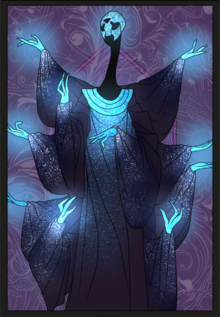
|
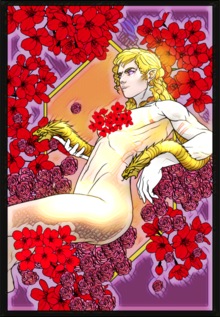
|
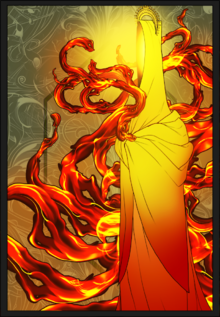
|

|
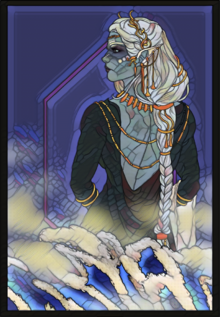
|
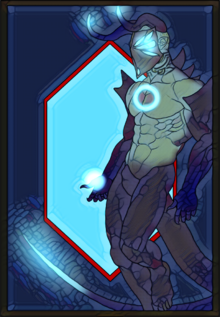
|

|

|
Priestly Activities
Estelley priests are referred to as Ordvaan. While there is no single authority on who is and is not an Ordvaan and anyone may declare themselves a part of the clergy, there are influential Ordvaan with the patronage of different segments of Estelley society who have staying power and the ability to regulate a sense of orthodox worship while denying extremist opinions. The Lanlath high priestesses of the Water-Mirror Grove set the standard of the correct way to worship Leyon, for example, while the Mana priests in Guldar under their Honored Mother define what the rites to Mana should look like and how often they should be performed. Being an Ordvaan does not bar one from other occupations as Estelley is a religion which encourages ambition, but Ordvaan are demanded to abstain from the self-interested corruption that is politics, as a priest with a stake in worldly affairs cannot be trusted.
Va'sil & Mana Trees
The Va'sil were holy and powerful entities sent directly by Estel, nature spirits who took the form of immense walking trees and manifested as ghostly avatars of Yanar, a symbol of her favor to that people and their culture. The Va'sil served the role of holy advisors for much of Allorn history, with the Lanlath having a special fondness for them but being unable to take them with them when they were expelled from the Allorn Empire and put to flight. Over time as the Allorn Empire drifted towards collapse and many of the people fell away from Estelley worship, the Va'sil and their groves were increasingly neglected. The act of treachery that created the Kathar race was the destruction of the Va'sil in the so-called Night of the Fallen Star, the coordinated destruction of their many groves and the vast majority of Estelley holy places across the Allorn Empire to knock the teetering religion off of its legs for good. It is this act more than any political separation which engendered such hatred towards the Kathar from the Estelley worshipers, because the loss of the Va'sil trees is something that can never be undone, comparable to Unionists just having to accept the death of a God or Dragon Worshipers having an entire clade of lesser Dragons wiped out and having to live with it forever. Non-worshipers often confuse Mana Trees for being Va'sil, but this term in fact refers to groves tended by Ordvaan that are considered safe havens for the faithful to socialize and discuss. The one thing that Mana Trees and Va'sil have in common is the lust Void Worshipers and their allies have for setting them on fire, something which most Estelley worshipers have experienced at least once in their lives, and many would die to prevent. Priests are charged with telling the story of the loss of the Va'sil, usually as mournful poetry or sad recollections of their ancestors who died protecting them, and with gathering the faithful at Mana Trees and ensuring their safety, or planting new ones if they are destroyed.
Vaalevara
Retelling of regional Elven history and folk tales is considered a sacred activity as Vaalevara, or the "memory of Empire." Priests are encouraged to look at the Geography page and its sub-pages as well as information about locations strewn across various Race and Culture pages to find inspiration for stories to tell about different locations, or failing that, to make a ticket in the Roleplay Community Discord to inquire after canon stories not presently listed on these pages. These stories can be on the smaller side, such as blessing the famous swan-boats of Amanra Assalei on the southern coast of Daen and discussing the ancient practices of the shipbuilders, to the grander side such as the cataclysmic battles between the Pride and Justice Arken during the Allorn days, with their most famous twelve-hour battle at Descäe Ilavan Lancaï or the "Spear's Rest" serving as one of the most common Elven re-enactments. Generally speaking, these retellings do not use the storyteller as the focus but center instead on important works of art or pieces of Estelley worshiper culture that can be used as inspiration to create things of beauty, or if they are lost, can be mourned.
Aelye
Collective moralization of the Estelley faithful is called Aelye, or the "good speech." It is the priest's responsibility to come up with at least two nice things to say about every member of their flock, and convene them for a gathering. There each person asks the priest to say nice things about one of the other people there, never themselves, and the priest does so until everyone is satisfied or has had at least one thing said about them. The idea is not mindless flattery or ignorance of one's flaws, but the account for the fact that the world is a busy and tired place and not everyone has the time to admit the positive feelings they have for one another. Aelye creates the environment necessary for usually uptight and closed-off Elves to lighten up a little bit and, even if disguised by implication and religious and flowery wording, show some kindness. Most popular by far among Mana worshipers and Sentli or Xotik Maquixtl, the most rural types of typical Estelley worshiper, Aelye can be seen as soft or perhaps overindulgent by the frigid Lanlath even if it is a valid ceremony which they participate in regardless.
Kathira
Collective punishment of a sinner by the Estelley faithful is called Kathira, or the "destruction of pride," the same root word that named the Kathar culture. The faithful form up into two long columns between which the accused must walk while the priest standing at the head of one of the lines recites their crimes for all to hear, with each worshiper in the line stating their own personal grievances and then striking the accused with a hand. Kathira can range in severity from a purely demonstrative ceremony meant to humble someone or even an ironic party trick performed purely in jest on someone whose virtue is beyond reproach with ridiculous accusations like having taken the last pastry, to a serious vigilante punishment where the punches are meant to bruise and disorient and the accused is brought near to collapse by the end of the line. While Estelley scripture prescribes that all wounds between the accused and the accuser are healed after this ceremony is performed, this very rarely if at all holds up in reality, and the punished almost always come back with a group of their friends to inflict violence on those who issued the punishment. As such, it is recommended and understood by most priests that Kathira is only to be performed on those who wish to show penance and will take its outcome seriously.
Peripheral Concepts
Peripheral Concepts are important thoughts from Estelley theology, that didn't necessarily fit anywhere else on this page, but also aren't strictly necessary to know. They cover a wider range of topics which Estelley believers have a solidified opinion of, or things that Estelley faithful might get questioned on in Roleplay and may be useful to have answers for.
Prophets
Estelley recognizes three prophets: Talea, Sanraan, and Fenhellëy, in this order. Each of them has a separate holy book that together form the three-part Estelley religious canon, with successive priests over generations doing their best to curate statements and minimize contradiction, though sometimes to little success, as Talea and Sanraan were bitterly opposed in life. Talea's dogma is quite warlike and brutal, as the Elves in her lifetime were disunited and had to be brought together by the sword. Far from the ethereal wise ones that they are today, the Elves of Talea's rule were a backwards, folkish, and unlearned people who needed a strong hand to unify into a centralized state. The prophetess herself favored Cemaan and cast her as the focal point of the Estelley religion, a traditionally Allorn viewpoint, but one that would later be subverted by those who dwell outside the Allorn Empire. Her younger brother Sanraan fought with her in what he considered the defense of the Elven people until he witnessed the divine intervention of the Estelley Gods to destroy the Dewamenet in order to save the early Allorn nation from complete destruction: witnessing what is described in apocalyptic terms as the "extinction of a continent, ground rotting under a sea of white chalk," he turned away from his sister's cause and seceded with the people who would later become the Suvial culture. Sanraan's dogma is compassionate and regretful, reminding the faithful that a poisonous victory can never last, and that building an empire on slavery, extermination, and oppression is like raising a castle in a field of clay, dooming it to slowly sink. Their youngest brother Fenhellëy spent the majority of his life as an unimportant clerk, before composing a series of treatises on proper rulership considered so well-worded that they must have been divinely inspired, and made the final part of the Estelley canon only after his death. Fenhellëy emphasized Leyon worship in his writings as the most important part of the Estelley religion, as it is Leyon who provides the benevolence and grace necessary for a continuity of stable civilization, and his virtues which create the longest lasting empires. Leyon worship however did not catch on as a dominant role until the time of the Lanlath's secession from the Allorn Empire, covered on the Lanlath culture's page.
Vaalya
Vaalya, meaning "regnance," is the Elven idea that only one mortal Empire at a time can claim rulership or dominance of the world. Beginning as the Dragon Worshiper concept of the Mantle of the World, the idea that Dragons created all things and passed the responsibility to steward them on to the living, this concept changed significantly over millennia of interpretation. Vaalya proposes that pluralism of ideas and difference of opinion is false, and all opposing dogma is somehow a flawed or incomplete version of Estelley dogma in the light of which worshipers were led astray. This concept is dominant even among more benevolent Estelley worshipers, leading to the arrogant and patronizing air that Elves are famous for, the idea that they stoop in their grace to uplift barbarians who do no not know better. As much as it seems an oppressive ideology to follow, there is some truth to this idea. For the Dewamenet Empire to arise the Meraic had to collapse, and for the Allorn Empire to achieve glory it had to destroy the Dewamenet, while the modern Regalian Empire is in turn built on the corpse of the Allorn Empire, sure to someday follow it and be replaced by something else. Not entirely about the correctness of Elves, it also proposes that this one dominant ideology always cycles and that power never lasts, a shifting and impermanent system where no legacy is truly meaningful except for those remembered by the people.
Worthiness
There is an overall concept in Estelley that it is the responsibility of each worshiper to do as much as they can in their lives to appear worthy of their company, the faith, and the standards of the Gods. This perfectionist attitude extends itself especially to Magic, Mages, and especially Godborn and Arkenborn, even those of Gods or Arken whom Estel's faithful do not look kindly on. Those who are rewarded with the blessing of a stronger birth, whether through a powerful Mage bloodline or direct descendance from a God, are expected to use that power to achieve great things. It does not matter if these things are done in good or evil: merely that they leave legacy and live up to the expectations of those who are responsible for granting that power. Many Estelley worshipers through history have spoken fondly of powerful enemies, not because they like them, but because they respect them for harnessing the gifts of their bloodline even if in opposition to Estelley virtues. The same idea can be extended to conversion of non-Elven worshipers to Estelley, that being that since it was not their destiny to be born into the faith, they must have migrated for a reason and are expected to prove themselves in a way that a native Elf might not. This means that some of Estelley's most violent and dogmatic zealots belong to the population of first-generation converts pushed to demonstrate their dedication by priests.
Trivia
- The holy caroling of the Estelley faithful, Isantha or the "Harmony of the Voices," is a haunting experience that can be heard ringing out streets away as each takes turns pronouncing a sacred verse one after the other.
- While Knighthood is an Ailor concept, Elven history is full of powerful Estelley religious orders and Mage circles that rival them in dogma and maintenance of legacy, one such group, the Senleya, gaining Regalian respect.
- The legitimacy of the revived Talea is a fierce topic among the Estelley faithful, many non-Allorn seeing her as illegitimate, or that even if she is legitimate, she has no right to return and expect to rule the world again.
| ||||||||||
| Accreditation | |||||||
|---|---|---|---|---|---|---|---|
|
| ||||||
